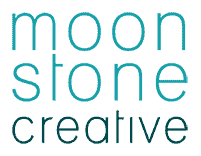Guest Blog Post for Moonstone Creative by Lynda Coulson Creative.
Have you ever found yourself absentmindedly scrolling through social media, and suddenly find you have been hooked by some great copywriting without realising it? You’ve read the first few lines of some social media copy on a post and are intrigued. You click on the “see more” link, and you read on. You aren’t even reading the whole post, scanning or jumping from the first paragraph to the third. Before you know it, and without consciously being aware, you have clicked on the “learn more” button. And now you are looking at a checkout with items in it, ready for you to enter your credit card details.
How did you get here?
There are usually a number of factors working together that make the magic of a sale come together. You may have been attracted by an image or a video, which motivated you to read the first couple of lines underneath. This part of the post has a hook, designed to stop you from scrolling and to see what this is about. You are interested and continue along this path (in marketing jargon we call this a funnel). Your interest in the brand offering get’s stronger and stronger. The more you read, the further through the funnel you progress. Until your email address is in and you’ve hit the PAY NOW button. This is where good copy earns its keep.
Let’s look at more reasons why copy can be the difference between a click and a close.
Brand Connection
When people talk about branding they assume it is only concerned your logo and the colours which represent your brand. Not true. Branding is about so many things. Seth Godin defines a brand as:
“A brand is the set of expectations, memories, stories and relationships that, taken together, account for a consumer’s decision to choose one product or service over another.“
Branding is about where you are positioned in the market. It embodies company culture. It is all of the things: visual representation, values and ethos, and customer service to name a few. How we communicate these things via imagery and words is how your customers are able to decide if your product is what they want and if they want to give you their money. Mess up the words, and you mess up the brand connection.
What makes a customer click
People click on a link because they experience a response from the content. In its simplest form, someone sees your website, advert or socials content and has a need or a want that your product could fill.
Let’s look at an example. A response to a piece of content will be determined by:
- Timing and Targets – consider a meal delivery service advert popping up at 6pm on a week night to a mum or dad in their early 40s.
- Visual – same scenario, using a photograph of a happy family sitting at the dinner table with a sparkling clean kitchen in the background.
- Message – same scenario again. With copy that discusses the difficulties of getting home from work and spending quality time with your children when there is a meal to prepare. “There must be another way!”
The message tells the story of the problem, the visual is the magical happy ending everyone wants and the timing is right when those frustrations are at their peak in the day for those feeling it most.
The customer can see their ideal outcome, and connects with the narrative.
This scenario is just one example of the importance of each element within a business’s brand.
Connecting all the Dots
If the language used doesn’t connect with the brand the message doesn’t land, and on that customer scrolls. For example, the target customer might be eco conscious. A pile of plastic containers on the table in the image won’t cut it and the copy should also play it’s part in portraying this key message. It should talk about compostable packaging and foods that are local and in season, for example.
If you get the imaging wrong, it won’t get past 1st base. However, get the copy wrong, and a fabulous image loses its value because in today’s social media land, there are plenty of good images where that comes from.
All elements need to be cohesive and high quality to break through the content noise. If the image is rubbish, it’s a scroll by. If the copy doesn’t do its part, the disconnect breaks the brand message, and the customer is lost.
There are many moving parts to getting a customer to the checkout, and without good copy, the marketing machine doesn’t work.
About Lynda
Lynda is a content creator who loves telling stories with words and photographs. To contact Lynda, see the links below:
www.lyndacoulsoncreative.com
www.instagram.com/lyndacoulsoncreative
